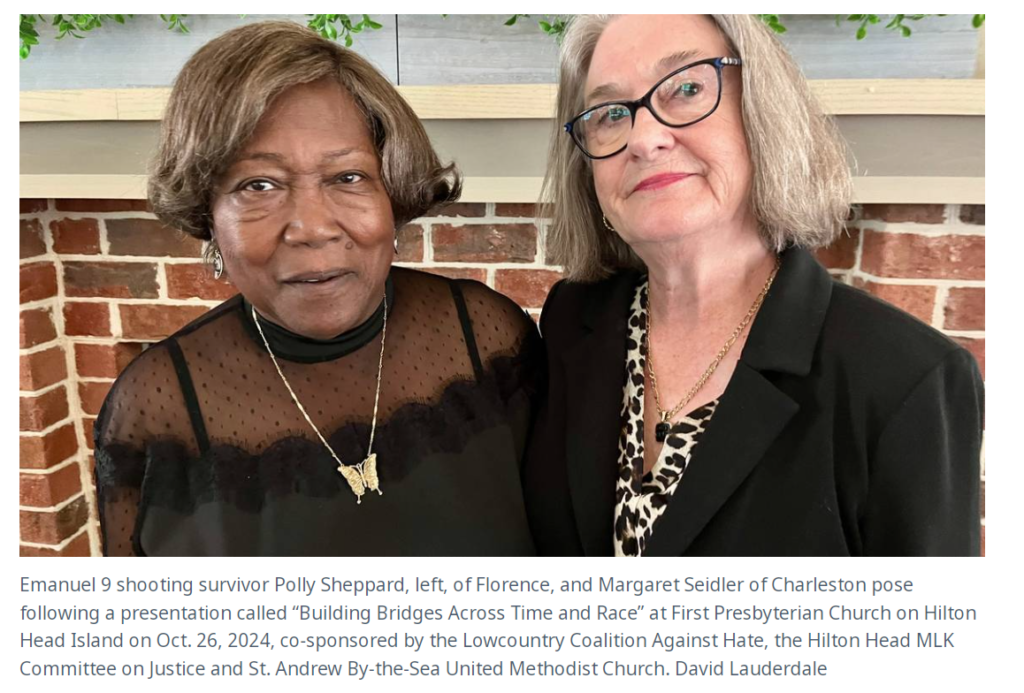OPINION
What a Charleston church shooting survivor and a descendant of slave brokers can teach us
| Opinion By David Lauderdale June 15, 2025 5:00 AM
Read more at: https://www.thestate.com/opinion/article308473920.html#storylink=cpy

Polly Sheppard was praying aloud when the Emanuel 9 killer pointed his gun at her and told her to shut up. “Did I shoot you yet?” asked the thin 21-year-old white supremacist who had just murdered nine Black people at a Bible study at the Emanuel African Methodist Episcopal Church in Charleston.
“No,” Sheppard responded to the visitor who had been welcomed to join them that night in trying to divine the meaning of a parable of Jesus.
“I’m not going to,” he replied. “I’m going to leave you here to tell the story.”
And that she has done, on national television, at the 2016 Democratic National Convention and in foreign countries — quite a feat for a retired county jail nurse, now 80 and recently widowed, who had zero experience in public speaking before.
Her message to people is one of forgiveness.
“I want them to hear that if you believe in God, anything can happen that you really want,” she told me in a phone call last week. “And then I want them to know, too, you will remain a victim all the time if it is about you. It’s not about you. It’s bigger than me. So, in order to be a survivor, you have to leave that victimhood alone and step out on faith.”
It helps to focus on other things, she said, like her scholarship fund for nurses who agree to work at least a year in a prison. Today, Sheppard often speaks as part of an unlikely duo.
Sheppard teams with Margaret Seidler, whose ancestry includes three generations of family who were slave brokers in downtown Charleston, where some 40% of enslaved Africans brought to North America debarked.
“While I can’t change the past, I can change what people learn about it and what they do about it today,” Seidler wrote in her 2024 book published by Evening Post Books, “‘Payne-Ful’ Business: Charleston’s Journey to Truth.”
The business of her fourth great-grandfather William Payne and his sons was the lucrative sale of 9,268 human beings in buildings now blending seamlessly into a bustling city that trades on Southern charm.
Her book, with artist John W. Jones adding humanity to souls coldly advertised for sale in newspaper ads, does not browbeat or belittle. It opens eyes to a racial reality that is rarely talked about. Seidler’s career in organizational training for big corporations has taught her that sweeping truth under the rug is never the solution.
She said the Emanuel 9 massacre changed her life.
“You know, we had a biracial president elected to two terms,” she said. “I mean, I just thought that things had gotten better.”
President Barack Obama, who identifies as Black, delivered the eulogy for pastor and state Sen. Clementa Pinckney. Obama told Sheppard afterward that she was going to have to help save the nation. “He wanted me to go out and tell what had happened to see if we could get some of these guns off the street,” she said.
She thinks the general public should see pictures of what she had to see: the horror of the bodies after mass shootings.
Sheppard and Seidler met in 2015 when Seidler chaired the committee to plan a tribute to the Emanuel 9 at the Charleston International Airport. They became friends. Seidler coached Sheppard on public speaking prior to the Democratic National Convention. And when Seidler’s book came out they decided their goal of harmony across the races could be strengthened by appearing together.
The unlikely duo has told their story to 3,900 people in groups across the state and region. And in 15 months, 4,000 copies of Seidler’s book have been sold.
This week, with the 10th anniversary, the world will again hear the Emanuel 9 story, and wrestle with racial divisions around the globe. But Seidler said the solution may be at the local level.
“I can’t change the national narrative,” she told me last week. “I have no impact on that. I’m not running for Congress. I’m 73 years old. So I’m focusing on local, and I know as a person working in change management that change is local.”
Sheppard agrees with that approach, which any of us can take.
“Change the people around you,” she said. “If you can change just one, you’ve done something. Keep talking. One is bound to listen.”
David Lauderdale may be reached at lauderdalecolumn@gmail.com.
